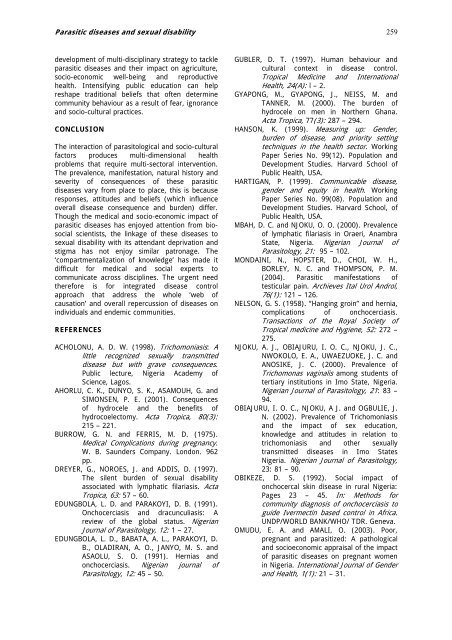ARI Volume 2 Number 1.pdf - Zoo-unn.org
ARI Volume 2 Number 1.pdf - Zoo-unn.org
ARI Volume 2 Number 1.pdf - Zoo-unn.org
- No tags were found...
You also want an ePaper? Increase the reach of your titles
YUMPU automatically turns print PDFs into web optimized ePapers that Google loves.
Parasitic diseases and sexual disability 259development of multi-disciplinary strategy to tackleparasitic diseases and their impact on agriculture,socio-economic well-being and reproductivehealth. Intensifying public education can helpreshape traditional beliefs that often determinecommunity behaviour as a result of fear, ignoranceand socio-cultural practices.CONCLUSIONThe interaction of parasitological and socio-culturalfactors produces multi-dimensional healthproblems that require multi-sectoral intervention.The prevalence, manifestation, natural history andseverity of consequences of these parasiticdiseases vary from place to place, this is becauseresponses, attitudes and beliefs (which influenceoverall disease consequence and burden) differ.Though the medical and socio-economic impact ofparasitic diseases has enjoyed attention from biosocialscientists, the linkage of these diseases tosexual disability with its attendant deprivation andstigma has not enjoy similar patronage. The‘compartmentalization of knowledge’ has made itdifficult for medical and social experts tocommunicate across disciplines. The urgent needtherefore is for integrated disease controlapproach that address the whole ‘web ofcausation’ and overall repercussion of diseases onindividuals and endemic communities.REFERENCESACHOLONU, A. D. W. (1998). Trichomoniasis: Alittle recognized sexually transmitteddisease but with grave consequences.Public lecture, Nigeria Academy ofScience, Lagos.AHORLU, C. K., DUNYO, S. K., ASAMOUH, G. andSIMONSEN, P. E. (2001). Consequencesof hydrocele and the benefits ofhydrocoelectomy. Acta Tropica, 80(3):215 – 221.BURROW, G. N. and FERRIS, M. D. (1975).Medical Complications during pregnancy.W. B. Saunders Company. London. 962pp.DREYER, G., NOROES, J. and ADDIS, D. (1997).The silent burden of sexual disabilityassociated with lymphatic filariasis. ActaTropica, 63: 57 – 60.EDUNGBOLA, L. D. and PARAKOYI, D. B. (1991).Onchocerciasis and dracunculiasis: Areview of the global status. NigerianJournal o f Parasitology, 12: 1 – 27.EDUNGBOLA, L. D., BABATA, A. L., PARAKOYI, D.B., OLADIRAN, A. O., JANYO, M. S. andASAOLU, S. O. (1991). Hernias andonchocerciasis. Nigerian journal ofParasitology, 12: 45 – 50.GUBLER, D. T. (1997). Human behaviour andcultural context in disease control.Tropical Medicine and InternationalHealth, 24(A): l – 2.GYAPONG, M., GYAPONG, J., NEISS, M. andTANNER, M. (2000). The burden ofhydrocele on men in Northern Ghana.Acta Tropica, 77(3): 287 – 294.HANSON, K. (1999). Measuring up : Gender,burden of disease, and priority settingtechniques in the health sector. WorkingPaper Series No. 99(12). Population andDevelopment Studies. Harvard School ofPublic Health, USA.HARTIGAN, P. (1999). Communicable disease,gender and equity in health. WorkingPaper Series No. 99(08). Population andDevelopment Studies. Harvard School, ofPublic Health, USA.MBAH, D. C. and NJOKU, O. O. (2000). Prevalenceof lymphatic filariasis in Oraeri, AnambraState, Nigeria. Nigerian Journal o fParasitology, 21: 95 – 102.MONDAINI, N., HOPSTER, D., CHOI, W. H.,BORLEY, N. C. and THOMPSON, P. M.(2004). Parasitic manifestations oftesticular pain. Archieves Ital Urol Androl ,76(1 ): 121 – 126.NELSON, G. S. (1958). “Hanging groin” and hernia,complications of onchocerciasis.Transactions of the Royal Society ofTropical medicine and Hygiene, 52: 272 –275.NJOKU, A. J., OBIAJURU, I. O. C., NJOKU, J. C.,NWOKOLO, E. A., UWAEZUOKE, J. C. andANOSIKE, J. C. (2000). Prevalence ofTrichomonas vaginalis among students oftertiary institutions in Imo State, Nigeria.Nigerian Journal of Parasitology, 21: 83 –94.OBIAJURU, I. O. C., NJOKU, A J. and OGBULIE, J.N. (2002). Prevalence of Trichomoniasisand the impact of sex education,knowledge and attitudes in relation totrichomoniasis and other sexuallytransmitted diseases in Imo StatesNigeria. Nigerian Journal of Parasitology,23: 81 – 90.OBIKEZE, D. S. (1992). Social impact ofonchocercal skin disease in rural Nigeria:Pages 23 – 45. In: Methods forcommunity diagnosis of onchocerciasis toguide Ivermectin based control in Africa.UNDP/WORLD BANK/WHO/ TDR. Geneva.OMUDU, E. A. and AMALI, O. (2003). Poor,pregnant and parasitized: A pathologicaland socioeconomic appraisal of the impactof parasitic diseases on pregnant womenin Nigeria. International Journal of Genderand Health, 1(1): 21 – 31.
















